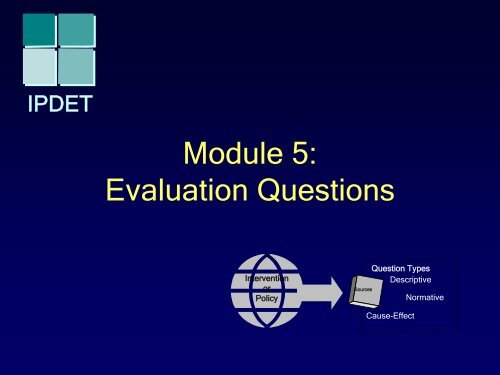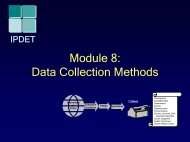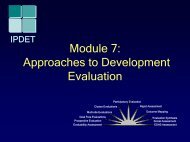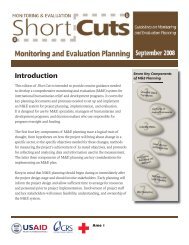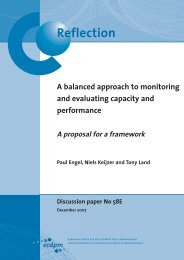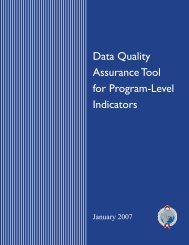Module 5: Evaluation Questions
Module 5: Evaluation Questions
Module 5: Evaluation Questions
You also want an ePaper? Increase the reach of your titles
YUMPU automatically turns print PDFs into web optimized ePapers that Google loves.
IPDET<br />
<strong>Module</strong> 5:<br />
<strong>Evaluation</strong> <strong>Questions</strong><br />
Intervention<br />
or<br />
Policy<br />
Sources<br />
Question Types<br />
Descriptive<br />
Normative<br />
Cause-Effect
Introduction<br />
• Sources of <strong>Questions</strong><br />
• Three Types of <strong>Questions</strong><br />
• Identifying and Selecting <strong>Questions</strong><br />
• Keys for Developing Good <strong>Questions</strong><br />
• Suggestions for Developing <strong>Questions</strong><br />
IPDET 2 2
<strong>Evaluation</strong> <strong>Questions</strong><br />
• Give direction to an evaluation<br />
• Critical element to help make decisions<br />
• State what you want to learn<br />
• Must be in terms you can measure<br />
IPDET 3 3
Sources<br />
• <strong>Questions</strong>, concerns, and values of stakeholders<br />
• <strong>Evaluation</strong> “models,” frameworks, and approaches<br />
such as heuristic (trial and error)<br />
• Models, findings, or important issues raised in the<br />
literature in the field<br />
• Professional standards, checklists, guidelines,<br />
instruments, or criteria developed or used elsewhere<br />
• Views and knowledge of expert consultants<br />
• The evaluator’s own professional judgment<br />
IPDET 4 4
Three Types of <strong>Questions</strong><br />
• Descriptive questions<br />
• Normative questions<br />
• Cause-Effect questions<br />
IPDET 5 5
Descriptive <strong>Questions</strong><br />
• Represent “what is”<br />
• Characteristics:<br />
– seek to understand or describe a program or<br />
process<br />
– provide a snapshot of what is<br />
– are straight forward questions, such as:<br />
• who? what? where? when? how? how much/many?<br />
– can be used to describe:<br />
• inputs, activities, outputs, outcomes<br />
IPDET 6 6
Examples of Descriptive<br />
<strong>Questions</strong><br />
• Who receives the program?<br />
• What are the characteristics of the program?<br />
• Where is the program delivered?<br />
• When was the program implemented?<br />
• How do the participants feel about the program?<br />
• How much did the program cost?<br />
• How many women participated in the program?<br />
• How were participants selected?<br />
IPDET 7 7
Normative <strong>Questions</strong><br />
• Compare “what is” to “what should be”<br />
– are we doing what we should be doing?<br />
– are we hitting our target?<br />
• Similar to questions asked in<br />
performance auditing<br />
• Measuring against a stated criteria<br />
IPDET 8 8
Examples of Normative<br />
<strong>Questions</strong><br />
• Did we spend as much as we had budgeted?<br />
• Did we reach our goal of admitting 5,000<br />
students per year?<br />
• Did we vaccinate 80% of children as<br />
planned?<br />
• Did we meet our objective of draining<br />
100,000ha of land?<br />
• Was the process for selecting participants<br />
fair/equitable?<br />
IPDET 9 9
Cause-Effect <strong>Questions</strong><br />
• Determine what difference the intervention<br />
makes<br />
• Attempt to measure what has caused change<br />
• Impact or cause-effect seek to determine the<br />
effects of a program<br />
• Ask whether the desired results have been<br />
achieved<br />
• Ask whether it is the intervention that has<br />
caused the results<br />
IPDET 10 10
Examples of Cause-Effect<br />
<strong>Questions</strong><br />
• Do program participants have new skills<br />
attributable to the program?<br />
• Do they have better paying jobs because of<br />
the program?<br />
• Is the poverty rate reduced because of the<br />
program?<br />
• Did draining the land result in the anticipated<br />
increased crop production?<br />
• Did it increase income for the farmers?<br />
IPDET 11 11
Determining Cause<br />
• Need to have the following:<br />
– logic model or program theory: the connection<br />
between the intervention and outcomes should<br />
make sense<br />
– time order: the interventions should come before<br />
the outcome<br />
– co-variation: both the intervention and the<br />
outcome should have the ability to change<br />
– elimination of rival explanations: need to be able to<br />
establish if it is the intervention, rather than other<br />
factors, that explain the changes<br />
IPDET 12 12
Choosing <strong>Questions</strong><br />
• Two phases:<br />
– divergent phase: develop a<br />
comprehensive list of questions<br />
– convergent phase: narrow down the list<br />
IPDET 13 13
Divergent Phase<br />
• Generate questions<br />
• Examine the questions<br />
• Organize the questions<br />
– classify each question as it fits into the<br />
labels of your model or framework<br />
IPDET 14 14
Example of Classifying<br />
from Logic Model<br />
Logic Model for a<br />
Micro-Lending Program<br />
Access to start-up<br />
funds for small<br />
businesses<br />
Income and<br />
employment for<br />
local people<br />
Improved living<br />
conditions<br />
Financial management<br />
advice and support<br />
Skills in business<br />
& financial<br />
management<br />
Reduced family<br />
poverty<br />
<strong>Questions</strong> about access to start up funds for small businesses<br />
<strong>Questions</strong> about income and employment for local people<br />
IPDET 15 15
Example of Classifying from<br />
a Program Outcome Model<br />
Inputs<br />
Activities<br />
Outputs<br />
Outcomes<br />
Impacts<br />
Resources<br />
Services<br />
Products<br />
Benefits<br />
Changes<br />
• money<br />
• staff<br />
• volunteers<br />
• supplies<br />
• training<br />
•education<br />
• counseling<br />
• total # of<br />
classes<br />
• hours of<br />
service<br />
• number of<br />
participants<br />
completing<br />
course<br />
<strong>Questions</strong> about resources<br />
<strong>Questions</strong> about services<br />
• new knowledge<br />
• increased skills<br />
• changed<br />
attitudes<br />
•new<br />
employment<br />
opportunities<br />
• money<br />
• staff<br />
• volunteers<br />
• supplies<br />
IPDET 16 16
Convergent Phase<br />
• Working with stakeholders, select the<br />
best questions<br />
• Eliminate interesting but not essential<br />
questions<br />
IPDET 17 17
Suggested Criteria to Narrow<br />
Down to Essential <strong>Questions</strong><br />
• Who would use the information? Who wants<br />
to know? Who will be upset if this evaluation<br />
question is dropped?<br />
• Would an answer to the question reduce<br />
present uncertainty or provide information not<br />
now readily available?<br />
• Would the answer to the question yield<br />
important information? Have an impact on the<br />
course of events?<br />
(continued on next slide)<br />
IPDET 18 18
Suggested Criteria (cont.)<br />
• Is this question merely of passing interest to<br />
someone, or does it focus on critical<br />
dimensions or continued interest?<br />
• Would the scope or comprehensiveness of<br />
the evaluation be seriously limited if this<br />
question were dropped?<br />
• Is it feasible to answer this question, given<br />
available financial and human resources,<br />
time, methods, and technology?<br />
IPDET 19 19
Matrix for Ranking and<br />
Selecting <strong>Questions</strong><br />
1<br />
2<br />
3<br />
4<br />
5<br />
6<br />
7<br />
Would the evaluation question…<br />
be of interest to key audiences?<br />
reduce present uncertainty?<br />
yield important information?<br />
be of continuing interest?<br />
be critical to the study’s scope and<br />
comprehensiveness?<br />
have an impact on the course of<br />
events?<br />
be answerable in terms of …<br />
Question # ____<br />
1 2 3 4 5 6 7 8 …<br />
IPDET 20 20
Keys to Building Good<br />
<strong>Questions</strong><br />
• Begin by identifying the major issues<br />
• Ask the questions that will help you learn if<br />
the issues have been affected by the policy or<br />
intervention<br />
• Compound questions are not good, it is<br />
necessary to separate the issues<br />
• <strong>Questions</strong> about an issue can be addressed<br />
using all three question types by adjusting the<br />
wording<br />
IPDET 21 21
Writing Better <strong>Questions</strong><br />
• There should be a link between each<br />
evaluation question and the purpose of the<br />
study<br />
• The issues of greatest concern should be<br />
addressed by the evaluation questions<br />
• The questions should be answerable; if not,<br />
change the question or acknowledge the<br />
limitations<br />
(continued on next slide)<br />
IPDET 22 22
Writing Better <strong>Questions</strong><br />
(cont.)<br />
• Be realistic about the number of questions<br />
that can be answered in a single evaluation<br />
• Focus on the important questions — the ones<br />
that must be answered as opposed to those<br />
that would be nice to know<br />
• Consider the timing of the evaluation relative<br />
to the program cycle:<br />
– <strong>Questions</strong> about impact are best answered after<br />
the intervention has been fully operational for a<br />
few years<br />
IPDET 23 23
To continue on to the<br />
Next <strong>Module</strong> click here<br />
To return to the<br />
Table of Contents click here


